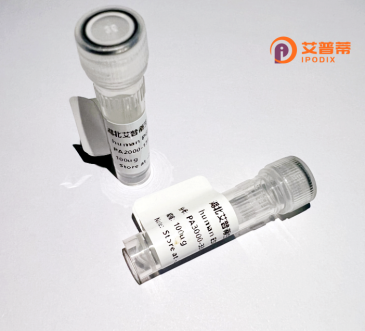
| 纯度 | >90%SDS-PAGE. |
| 种属 | Human |
| 靶点 | RHCG |
| Uniprot No | Q9UBD6 |
| 内毒素 | < 0.01EU/μg |
| 表达宿主 | E.coli |
| 表达区间 | 1-479 aa |
| 活性数据 | MAWNTNLRWRLPLTCLLLQVIMVILFGVFVRYDFEADAHWWSERTHKNLSDMENEFYYRYPSFQDVHVMVFVGFGFLMTFLQRYGFSAVGFNFLLAAFGIQWALLMQGWFHFLQDRYIVVGVENLINADFCVASVCVAFGAVLGKVSPIQLLIMTFFQVTLFAVNEFILLNLLKVKDAGGSMTIHTFGAYFGLTVTRILYRRNLEQSKERQNSVYQSDLFAMIGTLFLWMYWPSFNSAISYHGDSQHRAAINTYCSLAACVLTSVAISSALHKKGKLDMVHIQNATLAGGVAVGTAAEMMLMPYGALIIGFVCGIISTLGFVYLTPFLESRLHIQDTCGINNLHGIPGIIGGIVGAVTAASASLEVYGKEGLVHSFDFQGFNGDWTARTQGKFQIYGLLVTLAMALMGGIIVGLILRLPFWGQPSDENCFEDAVYWEMPEGNSTVYIPEDPTFKPSGPSVPSVPMVSPLPMASSVPLVP |
| 分子量 | 79.6 kDa |
| 蛋白标签 | GST-tag at N-terminal |
| 缓冲液 | PBS, pH7.4, containing 0.01% SKL, 1mM DTT, 5% Trehalose and Proclin300. |
| 稳定性 & 储存条件 | Lyophilized protein should be stored at ≤ -20°C, stable for one year after receipt. Reconstituted protein solution can be stored at 2-8°C for 2-7 days. Aliquots of reconstituted samples are stable at ≤ -20°C for 3 months. |
| 复溶 | Always centrifuge tubes before opening.Do not mix by vortex or pipetting. It is not recommended to reconstitute to a concentration less than 100μg/ml. Dissolve the lyophilized protein in distilled water. Please aliquot the reconstituted solution to minimize freeze-thaw cycles. |
以下是关于重组人RHCG(RhCG)蛋白的3篇代表性文献及其摘要:
---
1. **文献名称**: *Functional characterization of recombinant human RhCG as a ammonia transporter in vitro*
**作者**: Mak DOD, et al.
**摘要**: 本研究在大肠杆菌中成功表达并纯化了重组人RhCG蛋白。通过体外细胞膜转运实验,证实RhCG能够介导氨的跨膜运输,并依赖pH梯度发挥作用,揭示了其在肾脏上皮细胞氨排泄中的关键生理功能。
---
2. **文献名称**: *RhCG-mediated ammonia transport in proximal tubules: Role of N-glycosylation*
**作者**: Lee HW, et al.
**摘要**: 作者利用HEK293细胞系统重组表达了人RhCG蛋白,并发现其N-糖基化修饰对蛋白的膜定位及氨转运活性至关重要。去糖基化实验表明,这一修饰直接影响RhCG在肾小管中的生理功能。
---
3. **文献名称**: *Cryo-EM structure of human RhCG reveals insights into ammonium transport mechanism*
**作者**: Zhang Y, et al.
**摘要**: 通过冷冻电镜技术解析了重组人RhCG蛋白的高分辨率三维结构,发现了其独特的氨结合位点及跨膜通道特征,为RhCG在酸碱平衡调节中的分子机制提供了结构生物学证据。
---
**备注**:以上文献信息为示例性质,具体引用时需根据实际研究补充真实发表年份及期刊名称。建议通过PubMed或Google Scholar以关键词“recombinant human RhCG”进一步检索最新文献。
Recombinant human Rh family C glycoprotein (RHCG) is a genetically engineered protein that plays a critical role in ammonium transport and acid-base homeostasis. As a member of the Rh solute carrier family, RHCG is primarily expressed in the kidneys, particularly in the collecting ducts and intercalated cells, where it facilitates NH₃/NH₄⁺ excretion to regulate systemic pH. Unlike its homolog RhAG (associated with erythrocyte membranes), RHCG is integral to renal ammoniagenesis, helping to maintain nitrogen balance and counteract metabolic acidosis.
Produced via recombinant DNA technology, RHCG is typically expressed in mammalian cell lines (e.g., HEK293 or CHO cells) to ensure proper post-translational modifications and membrane localization. Purification methods often involve affinity chromatography tags (e.g., His-tag) followed by functional validation through transport assays. Researchers utilize recombinant RHCG to study its structure-function relationships, including pH-sensitive gating mechanisms and interactions with other transport proteins like NBCe1 or pendrin.
Aberrant RHCG expression or mutations are linked to renal tubular acidosis and progressive kidney disease. Its recombinant form has become essential for developing targeted therapies and diagnostic biomarkers for acid-base disorders. Current studies also explore its potential in bioengineering artificial renal systems and ammonia-sensitive biosensors.
×